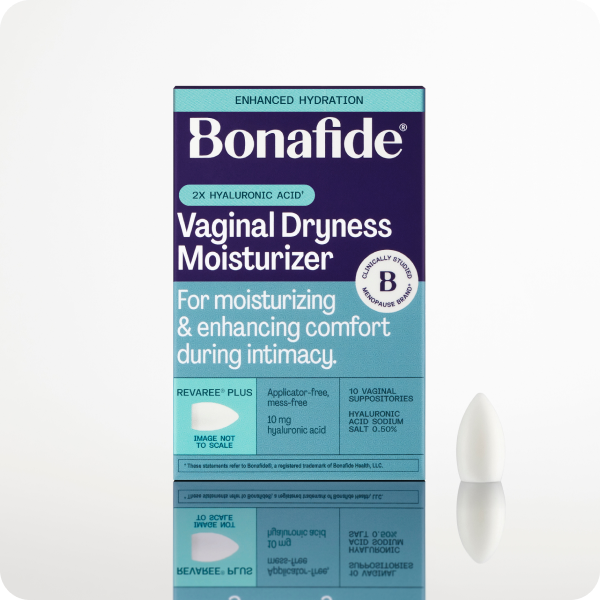When it comes to bladder health, declining estrogen levels, due to age, menopause, or other reasons, can lead to noticeable changes for women. In fact, urinary symptoms related to menopause are so common that the verbiage used by the medical community has been updated.
We in the gynecology world have abandoned the term “vulvovaginal atrophy” and now use “genitourinary syndrome of menopause” (GSM) to include a broader collection of genital and urinary symptoms that can occur during this life stage, rather than just limiting it to vaginal dryness; as the bladder is also considered to be an important organ of the genitourinary tract.
Here are some of the typical changes menopausal women may experience when it comes to bladder problems during menopause associated with low estrogen.
For a quick video on urinary changes often experience in menopause, check out this brief video from Dr. Alyssa Dweck, below.
Overactive Bladder in Menopause
Overactive bladder, also known as OAB, is poorly understood, but involves involuntary bladder muscle contractions followed by an intense urge to urinate. It can also involve potential increased bladder pressure or bladder leakage, even if the bladder isn’t full. Overactive bladder symptoms are quite commonplace, affecting millions of women due to declining estrogen levels.
Overactive bladder symptoms can include:
- A sudden and frequent urge to urinate with or without involuntary bladder leakage
- Urinary frequency (or the need to urinate) more than 8 times in a 24-hour period
- The need to awaken from sleep multiple times at night to urinate, which may or may not be accompanied by an increase in bladder pressure
These symptoms can be disruptive to day-to-day activities, possibly leading to the avoidance of exercise and intimacy and even potentially social isolation.
Overactive bladder treatments usually include making lifestyle and behavior modifications as a first step. Fluid restriction, especially during the hours before bed, and limiting caffeine and alcohol intake may help. Both caffeine and alcohol can act as diuretics and bladder irritants.
Prescription medications or local Botox injections are overactive bladder treatment options for some. If your symptoms related to overactive bladder persist or worsen, surgical intervention or nerve stimulation are more aggressive measures that can be discussed with your healthcare provider. It’s important to check in with your healthcare provide to make sure urinary symptoms are due to overactive bladder and not to another medical issue. This will ensure that appropriate treatment options are recommended.
Bladder Infections in Menopause, Including UTIs
Bladder infections, also known as cystitis, are the most common type of urinary tract infection (UTI). Cystitis is usually caused by bacterial overgrowth in the bladder and can have symptoms similar to overactive bladder.
You may be curious to know what bladder infection symptoms are in females. Frequent and urgent urination are hallmark symptoms of both overactive bladder and bladder infections. The official diagnosis of a bladder infection can be confirmed with a urinalysis and culture done by your healthcare provider. In order to treat a bladder or urinary tract infection, a short course of antibiotics is often prescribed.
Low estrogen levels during menopause can make women more prone to UTIs. The genital tissue becomes inelastic, less supple, thinner, and more prone to micro-abrasions, especially during sexual activity, which can lead to a UTI. Holding the urine for prolonged periods of time along with incomplete bladder emptying, which might accompany aging, can also increase the risk of a UTI.
Maintaining already healthy tissue with a regular vaginal moisturizer can help avoid UTIs in general. Optimizing the vaginal microbiome by avoiding disruptors (such as douching) and taking a probiotic geared towards vaginal health may also help with prevention. Remember, when looking to treat a urinary tract infection or bladder infection, it’s imperative to check-in with your healthcare provider.
Urinary Incontinence During Menopause
Urinary incontinence (UI) refers to involuntary bladder leakage and unintentional urinary leakage. There are several types of urinary incontinence. Stress incontinence is a mechanical issue in which coughing, sneezing, or straining puts pressure on the urethra and bladder, causing urinary leakage to occur. Pelvic organ relaxation — which is common in those who have had multiple or big babies, in addition to those who are above ideal body weight or who have a family history of such — commonly leads to these symptoms. Stress incontinence is not a symptom associated with overactive bladder, but it can be part of a mixed incontinence diagnosis.
Urge incontinence occurs when the sudden urge to urinate is so overwhelming that reaching the toilet becomes a challenge and bladder leakage occurs. Both menopausal overactive bladder and UTIs may lead to this form of urinary incontinence.
A thorough history and physical exam, a voiding diary, urine testing and urodynamic testing are used to diagnose and define urinary incontinence. Treatment will depend on this diagnosis and might include lifestyle modification, timed voiding, pelvic floor strengthening with Kegel exercises or formal pelvic floor physical therapy, medication or surgery.
When it comes to menopause and bladder problems in women, the question always arises, is it age-related or is it related to low estrogen during the menopause transition? In short, the answer is that it’s probably both. Either way, tools are available to help manage and prevent low estrogen bladder symptoms and any disruption they’re causing to your quality of life.











Comments
Post commentI have been dealing with bladder issues since I was in my mid-20s ( I just turned 70 last month), probably at least due to an oversexed partner I had then, and to multiple sclerosis which probably started when I was in my late 20s ( I didn’t get diagnosed till I was in my mid 40s)-just to let women know that there can be other situations affecting overactive or otherwise problematic bladder issues. I started having trouble completely voiding my bladder when I was in my mid thirties, which was probably one of the first symptoms I had leading to a diagnosis of MS. I found out when I was in my late 40s, from a visit to a urologist, and consequent urethral dilation, that I had scarring at the neck of my bladder, which was consistent with an MS diagnosis-it’s also probably why I’ve been so prone to bladder infections since I was in my thirties.